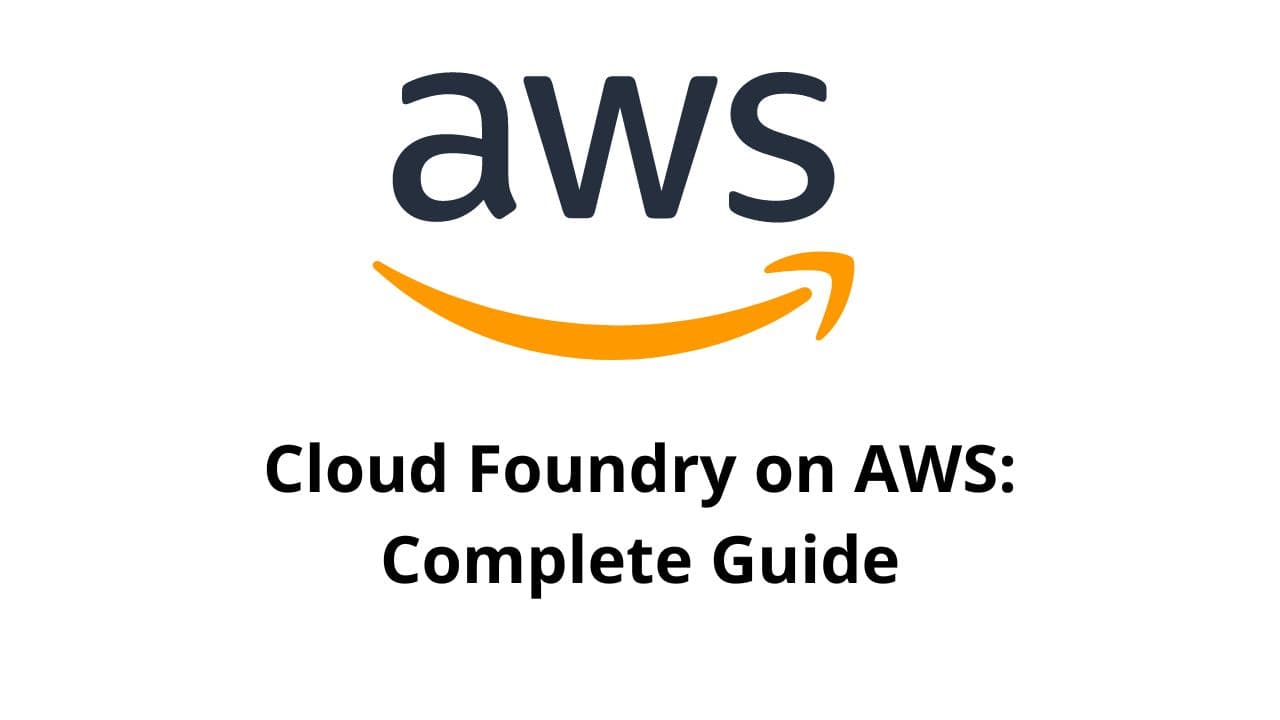Do you want to know what Cloud Foundry is on AWS? Why is it important for our app development? Read this cloud foundry tutorial for your complete guide on Cloud Foundry on AWS.
To facilitate and monitor apps throughout all development phases, Cloud Foundry was introduced in 2011. App developers can easily integrate their app infrastructure into its open source-based multi-purpose cloud platform and construct their apps easily.
what is cloud foundry used for?
AWS introduced its cloud foundry as Pivotal Cloud Foundry to develop and organize its AWS user’s apps on Amazon Web Services Clouds. They provide elasticity, reliability, and agility to your apps while running on an AWS environment.
To build and run our apps on AWS computing clouds throughout their development and execution lifecycles, we must utilize and understand what Cloud Foundry on AWS is. So that we can run our business through our apps smoothly and without additional maintenance costs.
Introduction to Cloud Foundry
Cloud Foundry is a software-based cloud platform that allows developers to design, distribute, operate, and expand apps. Developers can use coding in any computer language they like and select their app development tools.
VMware is the pioneer of this open-source platform based on virtual server-based clouds. Many app architecture providers now provide this service, including AWS, Microsoft, and IBM.
App developers can easily migrate their app infrastructure with the coding language of their choice on different app architecture service providers and enhance their app features using their advanced tools.
Essential components of Cloud Foundry:
Cloud Foundry is made up of seven major components:
| Routing Internet Traffic |
| Authentication of users |
| App lifecycle |
| App storage and execution |
| Service brokers |
| Messaging |
| Metrics and logging |
1. Routing Internet Traffic
This component helps navigate and monitor internet traffic coming from the cloud foundry platform to the desired location on our apps or their servers.
2. Authentication of Users
It never allows the user without authentication, uses an identification feature set for verified users, and applies a login server for application execution.
3. App Lifecycle
Another valuable component that helps deploy and manage our apps through their development and execution.
It allowed the integration of app features and added features of cloud foundry providers through all development phases.
Cloud computing is utilized by integrating control services that allow the application to adapt to cloud computing containers and monitor their performance by using cloud computing service provider enhanced features.
4. App Storage and Execution
It supports the ample file storage on which our app infrastructure data is based and stores it elastically in cloud storage. It helps app execution, including when to start and stop on service provider platforms.
5. Service Brokers
This feature helps in connecting apps to resources that are present on the service provider’s platform.
6. Messaging
Allows virtual machines to interact using HTTP or HTTPS protocols. It consists of the Observer server that keeps lengthy control data such as device IP addresses and the storage that retains and regularly updates information such as app status.
7. Metrics and Logging
It offers log monitors, which send logs to app designers, and the Metrics Collector, which gives information to help enterprises monitor their Cloud Foundry infrastructure.
Cloud Foundry on AWS
Pivotal Cloud Foundry was introduced by Amazon Web Services as an open-source platform to develop and test your advanced application on their platform. AWS users can install and create their desired app using different features on Amazon Web service providers.
It provides automatic scaling, handling app operations, elasticity, and monitoring for your apps. Users can use AWS PCF Brokers to enhance their app features and make them more reliable and responsive.
AWS PCF Service brokers provide a directory of services and facilities users can utilize. They systematically arrange all the features you can adapt to in your app’s execution and development. It connects your apps with all the resources available in that cloud foundry.
7 Benefits of Cloud Foundry on AWS
Pivotal Cloud Foundry on Amazon provides us with many benefits. A few of them are discussed below:
1. Enhance the Lifecycle of Apps
Pivotal Cloud Foundry on Amazon Web Services helps firms to enhance the lifecycle of their application deployments and expedite their digitalization, which grows their business in no time with efficiency and cost-saving strategies.
2. Improves the Productivity of Developers
Using PCF’s sophisticated tools and approaches, app developers can swiftly integrate their programming code in desired computer languages into their app’s infrastructure to execute their app flawlessly and improve their app productivity.
3. Apps are Easily Accessible
Using four levels of built-in layers of high availability, AWS users can keep their applications accessible and working even during busy periods when their applications are in high demand and keep your consumers engaged with them due to its good routing feature.
4. Improves the Security of Your Apps
Cloud Foundry Pivotal improves your app’s overall security with quick patches and creative identity management thanks to AWS’s enhanced features that make it safer for users and minimize the likelihood of it malfunctioning during a performance.
5. Boost Operational Efficiency
It boosts operational efficiency with installed monitoring, recording, and cloud computing abilities, which improves app safety and simplifies the administration of developers who can quickly build profitable apps.
6. Increases Elasticity of Your Apps
It improves the elasticity of your apps, as you need to add new features to your apps or control increasing traffic to them every day.
It automatically shrinks and expands your apps as per usage and helps them constantly develop and monitor.
The AWS Service Broker
It is used to integrate AWS and Pivotal Cloud Foundry containers and let the users utilize Cloud Foundry with added features of Amazon services like Amazon RDS, Amazon S3, Amazon SQS, etc., to let them develop valuable apps.
It is an open-source initiative that enables native AWS services to be directly accessible through third-party application platforms, including Red Hat, Kubernetes, VMware, and others. It allows easy incorporation of AWS resources into the application framework.
You can easily find it on AWS Quick Start for your app deployment. If you are an existing AWS user and want to migrate your app or develop it on the AWS platform, you can use Cloud Foundry from there.
The Significant Difference Between Amazon Cloud Formation and Cloud Foundry
| CloudFormation | Cloud Foundry |
| AWS Cloud Formation is employed to construct and administer a group of connected Amazon resources | Cloud Foundry, on the other hand, is employed to launch and manage apps quickly on any public or private cloud option |
| Where we may utilize pre-built templates or create our templates using Amazon resources and any third-party resources required | With the help of app service brokers, they can be used easily on other web service providers’ platforms |
| You are not required to determine the sequence in which AWS services must be provisioned | It is an open software container that offers our apps multicourse, advanced features, and cloud computing |
| You can easily integrate AWS resources in your app monitoring, development, and execution | It accelerates and simplifies app development, testing, deployment, and scaling |
11 Deployment Steps of PCF using Quick Start:
- Start creating AWS Route 53 to run your app in the AWS zone. They help you in controlling traffic as well as provide security.
- Then create AWS certificate manager certificates and choose a pivotal network account.
- Then after collecting the private token, launch your quick start stack.
- Check your progress through Cloudwatch, then login into your Pivotal Cloud Foundry manager.
- Clone, add, and install your command-line interface, then finally log into your Pivotal Cloud Foundry foundation.
- Finally, create an environment for your app and proceed toward the next step.
- Log into your Pivotal Cloud Foundry manager, click on the requirements you need, and download them.
- Now install your AWS Service Broker to integrate and use AWS’s other features.
- IAM manager checks the user’s identity, and you can integrate desired features and security parameters available on AWS after the authentication step.
- Use Provision AWS Polly Service to integrate your app with the services needed.
- Once all is set, deploy your app using AWS clouds and servers.
cloud foundry vs aWS
| Cloud Foundry | AWS |
| It is a PaaS service and is open source | AWS provides PaaS, IaaS, and SaaS as well, and it is not open source |
| Users can simply build, deploy and run their services here and make them available globally | AWS provides the same service as well along with many other options |
open cloud foundry on AWS
we have the PCF service available within AWS that can be used to build deploy and run applications in AWS using PCF.
AWS also gives the flexibility to use its other services along with PCF for a better user experience.
FAQS of what is cloud Foundry on AWS
Q: Which Platform Does Cloud Foundry Use?
It is now available on Amazon Web Services, Soft Layer, Microsoft, Google, OpenStack, VMware, and more platforms.
Q: Does AWS Endorse Cloud Foundry?
They introduced Cloud Foundry as Pivotal Cloud Foundry to develop and organize its AWS user’s apps on Amazon Web Services Clouds.
Q: Why Is Cloud Foundry Important?
It is essential as it provides an infrastructure for App developers to migrate their app architecture to different coding languages and use tools of their choice to enhance their app features.
Q: Why Is AWS Service Broker Important For Cloud Foundry On AWS?
It is used to integrate AWS and Pivotal Cloud Foundry containers and let the users utilize Cloud Foundry with added features of Amazon services.
Q: Is Cloud Foundry On AWS Secure?
Yes, it improves security with quick patches and identity management due to AWS’s enhanced features that make it safer for users.
Q: What Is The Primary Advantage Of Pivotal Cloud Foundry To AWS Users?
It provides a platform to deploy and develop their app in AWS quickly.
Final Words:
As an App developer, to easily integrate our app infrastructure into a cloud foundry open, software-based multi-purpose cloud platform, we must know what is Cloud Foundry on AWS to develop reliable apps quickly.
It helps our apps in various ways, such as routing traffic, performance monitoring, control of elastic storage, and execution.
Due to these marvelous features, they provide organizations with the best apps they need.
Other useful resources-
- Amazon Managed Services
- Amazon Redshift Vs Vertica
- What Is AMI In AWS
- Amazon Aurora PostgreSQL
- Amazon Elastic File System
- AWS Key Management Service
- What Is AWS Macie

I am an Amazon Web Services Professional, having more than 11 years of experience in AWS and other technologies. Extensively working in various AWS tools like S3, Lambda, API, Kinesis, Load Balancers, EKS, ECS, and many more. Working as a Solution Architect and Technology Lead for Architecting and implementing the same for different clients. He provides expert solutions around the world and especially in countries like the United States, Canada, United Kingdom, Australia, New Zealand, etc. Check out the complete profile on About us.


